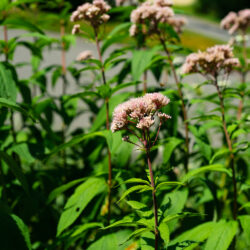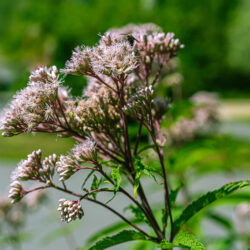Etymology
Eutrochium is Greek for wheel, referring to whorled pattern of the leaves; fistulosum is Latin for hollow.
Native Habitat
Meadows, margins of swamps and wetlands and forest edges. Only found wild in the southeastern corner of the state.
Garden Uses
Hollow Joe-Pye weed is beautiful in the rear of mixed borders or naturalized in meadows or rain gardens. It lasts well as a cut or dried flower.
Overview
The tallest of the Joe-Pye weeds, this species of herbaceous perennial can top 7' in height. Clumps can be as wide as 4' across. Despite its common name, other species of Eutrochium can also have hollow stems (E. maculatum).
Leaves and Stems
Leaves are simple, coarsely- toothed, dark green and whorled in groups of 4-7 along the hollow stems. Stems can be red, spotted red or in deep shade, green. Leaf length can reach 12".
Flowers
Flowers are lightly vanilla-scented and grow in large, domed, terminal inflorescences that can reach 12" to 18" in diameter. The dusty rose-colored disc flowers do not have the straps or rays seen in many species of this family.
Fruit/Seed
Small nutlets are shiny black when mature, and attached to fine bristles for wind dispersal; seed heads persist into winter.
Wildlife Associates
Hollow Joe-Pye weed attracts butterflies and numerous pollinators, and tolerates der browse. Seeds are eaten by sparrows. Insects over-winter in hollow stems, so delay cutting to ground until early spring.
Propagation
Sow seeds in autumn when dry (they have a low germination rate, so plant thickly), or divide clumps in the spring or autumn.
Ethnobotanical Uses
Some people make a diuretic tea from the leaves to treat a variety of urinary, kidney, and liver ailments.
Anecdotal Information
Genus has been changed to differentiate from Eupatorium (boneset), which has opposite leaves.
Sources
Lady Bird Johnson Wildflower Center
Plant Profile by Kate O'Dell


